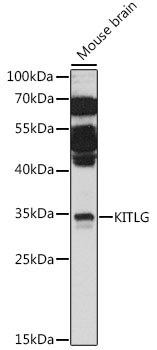Anti-KITLG Antibody (CAB16245)
- SKU:
- CAB16245
- Product type:
- Antibody
- Reactivity:
- Human
- Mouse
- Host Species:
- Rabbit
- Isotype:
- IgG
- Antibody Type:
- Polyclonal Antibody
- Research Area:
- Cell Biology
Description
| Antibody Name: | Anti-KITLG Antibody |
| Antibody SKU: | CAB16245 |
| Antibody Size: | 20uL, 50uL, 100uL |
| Application: | WB IF |
| Reactivity: | Human, Mouse |
| Host Species: | Rabbit |
| Immunogen: | Recombinant fusion protein containing a sequence corresponding to amino acids 26-214 of human KITLG (NP_000890.1). |
| Application: | WB IF |
| Recommended Dilution: | WB 1:500 - 1:2000 IF 1:50 - 1:200 |
| Reactivity: | Human, Mouse |
| Positive Samples: | Mouse brain |
| Immunogen: | Recombinant fusion protein containing a sequence corresponding to amino acids 26-214 of human KITLG (NP_000890.1). |
| Purification Method: | Affinity purification |
| Storage Buffer: | Store at -20°C. Avoid freeze / thaw cycles. Buffer: PBS with 0.02% sodium azide, 50% glycerol, pH7.3. |
| Isotype: | IgG |
| Sequence: | EGIC RNRV TNNV KDVT KLVA NLPK DYMI TLKY VPGM DVLP SHCW ISEM VVQL SDSL TDLL DKFS NISE GLSN YSII DKLV NIVD DLVE CVKE NSSK DLKK SFKS PEPR LFTP EEFF RIFN RSID AFKD FVVA SETS DCVV SSTL SPEK DSRV SVTK PFML PPVA ASSL RNDS SSSN RKAK NPPG DSSL H |
| Gene ID: | 4254 |
| Uniprot: | P21583 |
| Cellular Location: | Cell membrane, Cytoplasm, Secreted, Single-pass type I membrane protein, cytoskeleton |
| Calculated MW: | 26kDa/27kDa/30kDa |
| Observed MW: | 31kDa |
| Synonyms: | KITLG, DCUA, DFNA69, FPH2, FPHH, KL-1, Kitl, MGF, SCF, SF, SHEP7 |
| Background: | This gene encodes the ligand of the tyrosine-kinase receptor encoded by the KIT locus. This ligand is a pleiotropic factor that acts in utero in germ cell and neural cell development, and hematopoiesis, all believed to reflect a role in cell migration. In adults, it functions pleiotropically, while mostly noted for its continued requirement in hematopoiesis. Two transcript variants encoding different isoforms have been found for this gene. |
| UniProt Protein Function: | SCF: Ligand for the receptor-type protein-tyrosine kinase KIT. Plays an essential role in the regulation of cell survival and proliferation, hematopoiesis, stem cell maintenance, gametogenesis, mast cell development, migration and function, and in melanogenesis. KITLG/SCF binding can activate several signaling pathways. Promotes phosphorylation of PIK3R1, the regulatory subunit of phosphatidylinositol 3-kinase, and subsequent activation of the kinase AKT1. KITLG/SCF and KIT also transmit signals via GRB2 and activation of RAS, RAF1 and the MAP kinases MAPK1/ERK2 and/or MAPK3/ERK1. KITLG/SCF and KIT promote activation of STAT family members STAT1, STAT3 and STAT5. KITLG/SCF and KIT promote activation of PLCG1, leading to the production of the cellular signaling molecules diacylglycerol and inositol 1,4,5- trisphosphate. KITLG/SCF acts synergistically with other cytokines, probably interleukins. Homodimer, non-covalently linked (Probable). Heterotetramer with KIT, binding two KIT molecules; thereby mediates KIT dimerization and subsequent activation by autophosphorylation. Belongs to the SCF family. 3 isoforms of the human protein are produced by alternative splicing. |
| UniProt Protein Details: | Protein type:Membrane protein, integral Chromosomal Location of Human Ortholog: 12q22 Cellular Component: extracellular space; cytoskeleton; cytoplasm; integral to membrane; extracellular region; plasma membrane Molecular Function:protein binding; growth factor activity; cytokine activity; stem cell factor receptor binding Biological Process: epidermal growth factor receptor signaling pathway; fibroblast growth factor receptor signaling pathway; phosphoinositide-mediated signaling; nerve growth factor receptor signaling pathway; embryonic hemopoiesis; male gonad development; germ cell programmed cell death; signal transduction; positive regulation of MAP kinase activity; cell proliferation; positive regulation of peptidyl-tyrosine phosphorylation; negative regulation of mast cell apoptosis; positive regulation of melanocyte differentiation; innate immune response; positive regulation of Ras protein signal transduction; positive regulation of myeloid leukocyte differentiation; cell adhesion; neural crest cell migration; positive regulation of DNA replication Disease: Hyperpigmentation, Familial Progressive, 2; Skin/hair/eye Pigmentation, Variation In, 7 |
| NCBI Summary: | This gene encodes the ligand of the tyrosine-kinase receptor encoded by the KIT locus. This ligand is a pleiotropic factor that acts in utero in germ cell and neural cell development, and hematopoiesis, all believed to reflect a role in cell migration. In adults, it functions pleiotropically, while mostly noted for its continued requirement in hematopoiesis. Two transcript variants encoding different isoforms have been found for this gene. [provided by RefSeq, Jul 2008] |
| UniProt Code: | P21583 |
| NCBI GenInfo Identifier: | 134289 |
| NCBI Gene ID: | 4254 |
| NCBI Accession: | P21583.1 |
| UniProt Secondary Accession: | P21583,Q16487, Q68DZ2, Q7M4N8, Q9UQK7, A0AV09, A8K2Q4 B7ZLM4, |
| UniProt Related Accession: | P21583 |
| Molecular Weight: | Approximately 150 kDa |
| NCBI Full Name: | Kit ligand |
| NCBI Synonym Full Names: | KIT ligand |
| NCBI Official Symbol: | KITLG |
| NCBI Official Synonym Symbols: | SF; MGF; SCF; FPH2; KL-1; Kitl; SHEP7 |
| NCBI Protein Information: | kit ligand; c-Kit ligand; steel factor; stem cell factor; mast cell growth factor; familial progressive hyperpigmentation 2 |
| UniProt Protein Name: | Kit ligand |
| UniProt Synonym Protein Names: | Mast cell growth factor; MGF; Stem cell factor; SCF; c-Kit ligandCleaved into the following chain:Soluble KIT ligand; sKITLG |
| Protein Family: | SCF-associated factor |
| UniProt Gene Name: | KITLG |
| UniProt Entry Name: | SCF_HUMAN |









